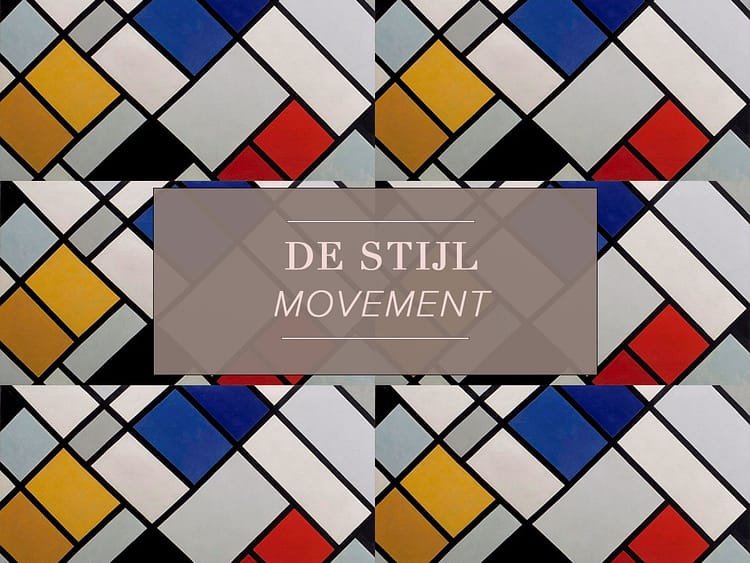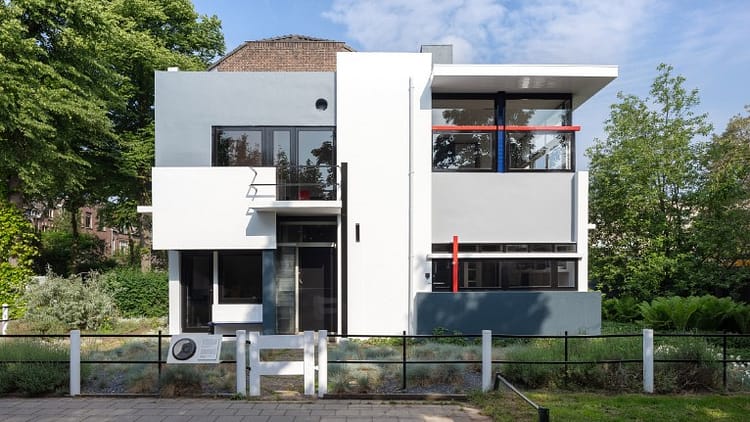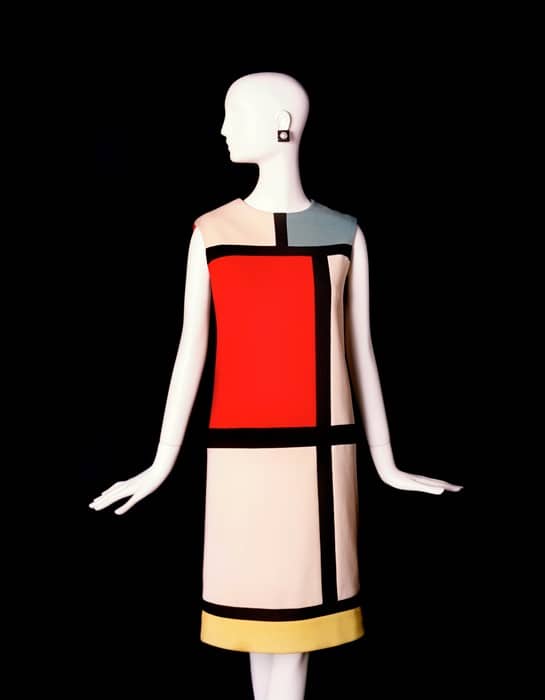
You can find all of my art blogs here! Also, please follow my art and design Instagram page _anitakenna_
STYLE/PERIOD
De Stijl (‘The Style’) was a Dutch movement founded in Leiden. The philosophy of De Stijl is known as Neoplasticism (new plastic art) and was influenced by Cubist painting and geometric forms. Van Doesburg and Mondrian theorized and pioneered the movement – as per Dempsey (2002, p. 122), they felt that “cubism had gone far enough in developing abstraction and that Expressionism was too subjective.” Furthermore, it was Mondrian who coined the term Neoplasticism.
The Tate (Anonymous, no date) states that “Neo-plasticism was in fact an ideal art in which the basic elements of painting – colour, line form – were used only in their purest, most fundamental state: only primary colours and non-colours, only squares and rectangles, only straight and horizontal or vertical lines”.
Consequently, some writers (Gorman, 2021) believed the movement was somewhat a reaction against the decorative excesses of Art Deco, the rejection of the excess of Art Nouveau, and a reaction to the “Modern Baroque” of the Amsterdam School movement. Moreover, writers noted that De Stijl favored a “… simple, logical style that emphasized construction and function, one that could be appropriate for every aspect of modern life.”
Architecture

Undoubtedly, De Stijl had a strong influence on architecture. The De Stijl architectural influence is probably most famously recognised in Rietveld Schroder House (designed by Rietveld (1923-1924)). Indeed, the building was considered a masterpiece of the De Stijl movement. Certainly, Rietveld Schroder house was designed based on De Stijl’s principles (evidenced in its play between lines, angles, colours, etc.).
De Stijl’s architecture clearly demonstrated similar clarity and order to that of De Stijl’s paintings. This similarity was established through, for example, straight lines, right angles, clean surfaces, and three dimensions.
Current Day
There continues to be a strong interest in De Stijl, with exhibitions still frequently held worldwide. For example, The Hague holds a large Mondrian collection that is still popular with visitors. Furthermore, the Rumyantsevo and Salaryevo stations of Moscow Metro show De Stijl influences (opened 2016).
Following Van Doesburg’s death, many of De Stijl’s artists, architects, and designers looked to other avant-garde movements (for example, Abstract-Creation and elements of International Style architecture).
COLOURS/THEMES

Guggenheim (Anonymous, no date) proficiently describes De Stijl style as being “…posited on the fundamental principle of the geometry of the straight line, the square, and the rectangle, combined with a strong asymmetricality; the predominant use of pure primary colors with black and white; and the relationship between positive and negative elements in an arrangement of non-objective forms and lines.“.
Components of De Stijl style include:
- Abstraction
- Construction
- Function
- Universal form, colour, simplicity, and logic. For example, visual compositions were usually simplified (unlike the decorative style previously seen).
- The use of primary colours (black, grey, and white often feature too).
- Its use of vertical and horizontal lines as part of a composition.
- It was a visual language of rendered geometric forms. For example, rectangles and squares in geometric shapes were often carefully arranged in a grid format.
- It was a universal style in painting, architecture, and design.
- It held a core thinking/a spiritual world order attitude.
- Balance: an aesthetic balance was present in De Stijl. For example, an opposition with the construction of crossing joints (commonly seen in carpentry) exemplified this.
Theo van Doesburg’s geometric sans-serif typeface further exemplifies features of the De Stijl movement. This typeface was designed using perpendicular and evenly weighted strokes and based upon a square divided into 25 smaller squares.
MAIN PRACTITIONERS
The De Stijl’s founding was an alliance of artists, architects, and designers. This group were ultimately brought together by the painter and architect Theo van Doesburg. Indeed, Van Doesburg is recognized as the founder and leader of De Stijl. He was familiar with the work of Piet Mondrian and influenced by the abstraction of reality in Mondrian’s work.
Piet Mondrian is recognized as a pioneer and considered the most famous of the movement (and his time). You can see a similarity in his and Van Doesburg’s work. An example of this is when you compare Van Doesburg’s ‘Counter-Composition in Dissonance 16 (1925)’ (see Fig 3 below) to much of the work of Mondrian.
Doesburg contacted Mondrian and, together with several other creatives (Bart van der Leck (painter), Antony Kok (writer and poet), Vilmos Huszar (painter), and Jacobus Oud (architect)), they founded the magazine De Stijl. Marc Schenker (2021) notes in his blog for ‘Creative Market’ that “At the height of its popularity, the movement had 100 official members while the journal had a circulation of 300”.

Mondrian’s work sought to create order, clarity and a universal aesthetic language through abstraction. Harmony and balance were important elements of his work. In 1924, Mondrian left the group following differences in the style between group members. Predominately, this was due to Doesburg insisting on dynamical diagonal lines being favored instead of horizontal and vertical (as outlined in Daily Art Magazine (Otto, 2020)). However, Mondrian never used diagonals; he continued to refine his work based on De Stijl’s principles of pure colour and form.
Mondrian has influenced many abstract artists, while Van Doesburg diverged into Elementarism and Concrete Art.
Other Important Practitioners
Another famous work incorporating the characteristic of De Stijl’s is that of the ‘Red and Blue Chair (1923)’ by Gerrit Rietveld. Notably, Rietveld also designed Rietveld Schroder House.
Red and Blue chair was composed of a black frame and primary colours. It impressively plays with the lines that interact within the work. Additionally, these lines consistently manage to avoid the intersection of the design work. Indeed, every colour, line, and plane is clearly defined within the piece. According to Dempsey (2002, p. 12), “This chair was the first use of neo-plastic design theory in applied arts”.
Two other architects influencing De Stijl were (1) Dutch Hendrik Petrus Berlage, who showed elements of congenial rationalism in his design, and (2) USA Frank Lloyd Wright, who designed harmonious works. Another principal member of the movement includes the architect Robert van‘t Hoff.

You can also see the influence of Wassily Kandinsky in some of the work which formed the basis of De Stijl. Indeed, Van Doesburg was particularly inspired by Wassily Kandinsky. Thus, Van Doesburg sought to move to more abstract and spiritual visual representation (where painting moved to more of an abstraction and the mind rather than everyday life).
Passing of Theo van Doesburg
Van Doesburg traveled to lectures and arranged many exhibitions. Also, Van Doesburg was briefly affiliated with Dada and Russian Suprematism and Constructivism through El Lissitzky. It is likely due to his international travels that De Stijl started to change in the 1920s. Hence, new members (such as Lissitzky) joined, while older members left the group due to this change of direction. During the 1920s, De Stijl became international.
Following Doesburg’s death in 1931, the De Stijl group faded and ceased to exist without its key founding member. Some De Stijl artists, such as Rietveld, remained with the central theory of De Stijl’s principles in his furniture design. De Stijl influenced the Bauhaus style movement that followed, as well as clothing and interior design.
FORCES THAT SHAPED THE MOVEMENT
In the aftermath of the horror of World War I, De Stijl wished to remake society. Subsequently, the movement wanted to find and create new art in the spirit of peace and harmony and alter society (which they believed had been discredited).
Similar to artists and writers of that time, designers and architects wished to turn away from old forms and philosophies dating World War I. Evidently, it was somewhat of an embracing of a utopian vision of art where they sought a more universal and ethical culture.
ADDITIONAL OBSERVATIONS
Typography: As mentioned, the De Stijl typeface followed a similar theme of geometric shapes as much of the De Stijl movement. This style is evident in Van Doesburg’s sans-serif typeface Architype Van Doesburg.
Layout/Negative Space: Though De Stijl may sometimes look quite simple, there’s a lot of thought put into its grid layout to find a perfect balance. There is an aim for a balance between the arrangement of negative space and the lines/geometric shapes within the piece.
Motifs: Motifs were based on geometric forms made of straight lines and basic geometric shapes.
SIMILARITIES TO CONTEMPORARY DESIGN/DESIGNERS?

De Stijl has had a strong influence on the fashion industry. It has repetitively re-surfaced in trends that stem influences from some of the colour and themes of De Stijl – specifically, that of colour-blocking trends.
As recent as this year, Vogue magazine, among many other publications, announced that colour blocking was back in fashion. Furthermore, the article outlined how it had been hugely in fashion only ten years prior too. Louis Vuitton’s Spring/Summer 2021 collection unveiled several works that strongly reminded me of De Stijl. Vuitton’s use of colour blocking, such as the bold blue with pops of yellow, evidenced a throwback to the De Stijl movement.
REVIEW SIMILARITIES & DIFFERENCES TO A CONTEMPORARY WORK
The simple shapes, geometric features, use of primary colours, and simplicity of De Stijl have influenced contemporary and minimalistic design right up to today. There is a timelessness to De Stijl’s style. This timelessness is seen through fashion trends that continue to re-emerge based on De Stijl’s influences. While Yves Saint Laurent popularised the Mondrian dress in the 1960s (and made the front cover of Vogue with it), we continue to see features of De Stijl in current-day fashion. This influence was evident in the 2021 Spring-Summer fashion shows.
Many top designers used colour blocking in their 2021 shows (ranging from Louis Vuitton to Bottega Veneta). While not directly in line with De Stijl’s features, the use of balance, spacing, and colour blocking (primarily using primary colours) can be seen in these recent fashion trends.






What is the Product and its Use?
The product I compare current influence of De Stijl to is clothing. Thus, the product also follows one of the main features (functionality) of De Stijl.
What Influence/s does it take?
- Colours: A lot of primary colours (blue, red, and yellow) in the Spring Summer 21 collection.
- Typography: Although there is little use of typography in much of the clothing, Vogue Article shows a piece by Raf Simons (Spring 2021, see Fig 7) that includes text. Here, I can see the influences of De Stijl in the ‘Children of the Revolution’ typeface used in this piece. The influence I see is the simplicity of the typeface. The typeface is composed mainly of a sans-serif style. Also, the majority of its strokes are evenly weighted. Nevertheless, there are apparent differences. However, the basis of the simplicity and the lack of strong/decorative shapes and strokes is where I see influence from De Stijl.
- Patterns and Style: Though many of the clothes lack in geometric shapes and lines (as seen in De Stijl), there is the same sense of seeking for an evenly distributed aesthetic. Furthermore, this can be seen through the blocking. The blocking appears to be very thoughtfully distributed to find a balance and is carefully considered in the arrangement of the garments. I see the lines as acting as the contrast between each garment (for example, the blunt line between a blue top and red trousers).

Find a Historical Comparison to Contrast it with:
Reviewing Mondrian’s below work (‘Composition en rouge, jaunce, bleu et noir’), we see a similar use of colours, simplicity, and colour blocking. Comparatively, we see a similar aesthetic balance found in the style of the painting versus the styles featured on the catwalk for Spring Summer 21.

How does it Differ from the Movement?
The garments we reviewed do not solely rely on primary colours. Furthermore, they are not confined to a simplistic style/the use of geometric patterns. Also, there are other typeface styles used on many modern-day clothing.
PICTOGRAPHY
Fig 1: Poelstra, Stijn, (no date), No title (Iconic Houses: Rietveld Schröder House). Available at https://www.archilovers.com/stories/27133/iconic-houses-rietveld-schroder-house.html (Accessed: 21 May 2021)
Fig 2: Guirkinger, Alexandre (no date), Robe hommage à Piet Mondrian ©Musée Yves Saint Laurent Paris. Available at https://www.anothermag.com/fashion-beauty/10534/the-yves-saint-laurent-show-where-art-and-fashion-collided (Accessed 11 Feb 2024)
Fig 3: Photographer Unknown – The Art Story, (no date) Counter-Composition in Dissonance 16 (1925). Available at https://www.theartstory.org/artist/van-doesburg-theo/artworks/ (Accessed 21 May 2021)
Fig 4: Photographer Unknown, (no date) Red Blue Chair 1918-1923. Available at https://terraingallery.org/aesthetic-realism-art-criticism/gerrit-rietvelds-red-and-blue-chair-what-i-learned-about-rest-and-motion-in-myself/ (Accessed: 21 Jan 2024)
Fig 5: Photographer Unknown – Courtesy of Colville, (2021), Colville spring 2021. Available at https://www.vogue.com/article/color-blocking-trend-2011-2021 (Accessed: 21 May 2021)
Fig 6.1: Oh, Phill, (2012), Elisa Nalin, right, photographed by Phil Oh in 2012. Available at https://www.vogue.com/article/color-blocking-trend-2011-2021 (Accessed: 21 May 2021)
Fig 6.2: Oh, Phill, (2012), Hanne Gaby Odiele photographed by Phil Oh in 2012. Available at https://www.vogue.com/article/color-blocking-trend-2011-2021 (Accessed: 21 May 2021)
Fig 6.3: Photographer Unknown – Courtesy of Louis Vuitton, (2021), Louis Vuitton spring 2021 menswear. Available at https://www.vogue.com/article/color-blocking-trend-2011-2021 (Accessed: 21 May 2021)
Fig 6.4: Fior, Filippo, (2012), Raf Simons spring 2012. Available at https://www.vogue.com/article/color-blocking-trend-2011-2021 (Accessed: 21 May 2021)
Fig 6.5: Photographer Unknown – Courtesy of Bottega Veneta, (2021), Bottega Veneta resort 2021. Available at https://www.vogue.com/article/color-blocking-trend-2011-2021 (Accessed: 21 May 2021)
Fig 6.6: Photographer Unknown, (2011), Outside Paris Fashion Week in 2011. Available at https://www.vogue.com/article/color-blocking-trend-2011-2021 (Accessed: 21 May 2021)
Fig 7: Photographer Unknown – Courtesy of Raf Simons, (2021), Raf Simons spring 2021. Available at https://www.vogue.com/article/color-blocking-trend-2011-2021 (Accessed: 21 May 2021)
Fig 8 – Photographer Unknown – Mondrian/Holtzman Trust, (2007), Composition C (No.III) with Red, Yellow and Blue. Available at https://www.tate.org.uk/kids/explore/who-is/who-piet-mondrian (Accessed 21 May 2021)
BIBLIOGRAPHY
Dempsey, Amy, (2002), Styles, Schools and Movements, Thames & Hudson Ltd. London
Anonymous, “NEO-PLASTICISM” [on-line], no date, at https://www.tate.org.uk/art/art-terms/n/neo-plasticism (Accessed: 21 May 2021)
Gorman, Isobel, (2021), week 2 Graphic Design Certificate slides, Dublin Institute of Design
Anonymous, “Movements > De Stijl” [on-line], no date, at https://web.archive.org/web/20140429120104/http://www.guggenheim.org/new-york/collections/collection-online/movements/195212/description (Accessed: 21 May 2021)
Schenker, Marc (2021), “Design Trend Report: De Stijl Design” [on-line], Sept 2021, at https://creativemarket.com/blog/de-stijl-design-trend (Accessed: 5 Feb 2024)
Otto, Celia Leiva, (2020) “How to Read Piet Mondrian”, Daily Art Magazine, 27 April. Available at https://www.dailyartmagazine.com/how-to-read-piet-mondrian/ (Accessed: 21 May 2021)
Dujardin, Alain, “This 100-Year-Old Dutch Movement Shaped Web Design Today” [on-line], 2017, at https://www.wired.com/2017/01/this-100-year-old-dutch-movement-shaped-web-design-today/?curator=MediaREDEF#.kphtjs1er (Accessed: 21 May 2021)



0 Comments